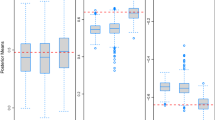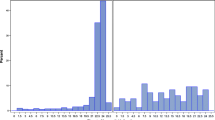Abstract
A common objective of cohort studies and clinical trials is to assess time-varying longitudinal continuous biomarkers as correlates of the instantaneous hazard of a study endpoint. We consider the setting where the biomarkers are measured in a designed sub-sample (i.e., case-cohort or two-phase sampling design), as is normative for prevention trials. We address this problem via joint models, with underlying biomarker trajectories characterized by a random effects model and their relationship with instantaneous risk characterized by a Cox model. For estimation and inference we extend the conditional score method of Tsiatis and Davidian (Biometrika 88(2):447–458, 2001) to accommodate the two-phase biomarker sampling design using augmented inverse probability weighting with nonparametric kernel regression. We present theoretical properties of the proposed estimators and finite-sample properties derived through simulations, and illustrate the methods with application to the AIDS Clinical Trials Group 175 antiretroviral therapy trial. We discuss how the methods are useful for evaluating a Prentice surrogate endpoint, mediation, and for generating hypotheses about biological mechanisms of treatment efficacy.





Similar content being viewed by others
References
Cao W, Tsiatis A, Davidian M (2009) Improving efficiency and robustness of the doubly robust estimator for a population mean with incomplete data. Biometrika 96(3):723–734
Dafni U, Tsiatis A (1998) Evaluating surrogate markers of clinical outcome when measured with error. Biometrics 54(4):1445–1462
DeGruttola V, Tu X (1994) Modeling progression of CD4-lymphocyte count and its relationship to survival time. Biometrics 50(4):1003–1014
Gilbert P, Yu X, Rotnitzky A (2014) Optimal auxiliary-covariate-based two-phase sampling design for semiparametric efficient estimation of a mean or mean difference, with application to clinical trials. Stat Med 33(6):901–917
Guo X, Carlin B (2004) Separate and joint modeling of longitudinal and event time data using standard computer packages. Am Stat 58(1):16–24
Hall P, Racine J, Li Q (2004) Cross-validation and the estimation of conditional probability densities. J Am Stat Assoc 99(468):1015–1026
Hammer S, Katzenstein D, Hughes M, Gundacker H, Schooley R, Haubrich R, Henry W, Lederman M, Phair J, Niu M, Hirsch M, Merigan T (1996) A trial comparing nucleoside monotherapy with combination therapy in HIV-infected adults with CD4 cell counts from 200 to 500 per cubic millimeter. N Engl J Med 335(15):1081–1090
Haneuse S, Saegusa T, Lumley T (2011) osDesign: an R package for the analysis, evaluation, and design of two-phase and case-control studies. J Stat Softw 43(11):1–29
Haynes B, Gilbert P, McElrath M, Zolla-Pazner S, Tomaras G, Alam S, Evans D, Montefiori D, Karnasuta C, Sutthent R, Liao H, DeVico A, Williams Lewis C GK, Pinter A, Fong Y, Janes H, DeCamp A, Huang Y, Rao M, Billings E, Karasavvas N, Robb M, Ngauy V, de Souza M, Paris R, Ferrari G, Bailer R, Soderberg K, Andrews C, Berman P, Frahm N, De Rosa S, Alpert M, Yates N, Shen X, Koup R, Pitisuttithum P, Kaewkungwal J, Nitayaphan S, Rerks-Ngarm S, Michael N, Kim J (2012) Immune-correlates analysis of an HIV-1 vaccine efficacy trial. N Engl J Med 366(14):1275–1286
Henderson R, Diggle P, Dobson A (2000) Joint modelling of longitudinal measurements and event time data. Biostatistics 1(4):465–480
Kobayashi F, Kuroki M (2014) A new proportion measure of the treatment effect captured by candidate surrogate endpoints. Stat Med 33(19):3338–3353
Lin D, Fleming T, DeGruttola V (1997) Estimating the proportion of treatment effect explained by a surrogate marker. Stat Med 16(13):1515–1527
Prentice R (1982) Covariate measurement errors and parameter estimation in a failure time regression model. Biometrika 69(2):331–342
Prentice R (1986) A case-cohort design for epidemiologic cohort studies and disease prevention trials. Biometrika 73(1):1–11
Prentice R (1989) Surrogate endpoints in clinical trials: definition and operational criteria. Stat Med 8(4):431–440
Qi L, Wang C, Prentice R (2005) Weighted estimators for proportional hazards regression with missing covariates. J Am Stat Assoc 100(472):1250–1263
Rizopoulos D, Verbeke G, Lesaffre E (2009) Fully exponential Laplace approximations for the joint modelling of survival and longitudinal data. J R Stat Soc Ser B (Stat Methodol) 71(3):637–654
Self S, Pawitan Y (1992) Modeling a marker of disease progression and onset of disease. In: Jewell N, Dietz K, Farewell V (eds) AIDS Epidemiol. Birkhäuser, Boston, pp 231–255
Song X, Davidian M, Tsiatis A (2002) An estimator for the proportional hazards model with multiple longitudinal covariates measured with error. Biostatistics 3(4):511–528
Tsiatis A, Davidian M (2001) A semiparametric estimator for the proportional hazards model with longitudinal covariates measured with error. Biometrika 88(2):447–458
Tsiatis A, Davidian M (2004) Joint modeling of longitudinal and time-to-event data: an overview. Stat Sin 14:809–834
Tsiatis A, DeGruttola V, Wulfsohn M (1995) Modeling the relationship of survival to longitudinal data measured with error. Applications to survival and CD4 counts in patients with AIDS. J Am Stat Assoc 90(429):27–37
Wang C (2006) Corrected score estimator for joint modeling of longitudinal and failure time data. Stat Sin 16:235–253
Wang C, Xie S, Prentice R (2001) Recalibration based on an approximate relative risk estimator in Cox regression with missing covariates. Stat Sin 11:1081–1104
Wu L, Liu W, Yi G, Huang Y (2012) Analysis of longitudinal and survival data: joint modeling, inference methods, and issues. J Probab Stat. doi:10.1155/2012/640153
Wulfsohn M, Tsiatis A (1997) A joint model for survival and longitudinal data measured with error. Biometrics 53(1):330–339
Acknowledgments
This work was supported by the National Institute Of Allergy And Infectious Diseases of the National Institutes of Health [Award Numbers R37AI054165, UM1AI068635], and by the Bill and Melinda Gates Foundation [Award Number OPP1110049]. The content is solely the responsibility of the authors and does not necessarily represent the official views of the NIH or BMGF. The authors thank Ching-Yun Wang for statistical input, the AIDS Clinical Trials Group (ACTG) operations, laboratory, and statistical data management centers for generating and providing the ACTG 175 data, and the ACTG 175 study participants and investigators, in particular protocol chair Scott Hammer who reviewed and approved this work.
Author information
Authors and Affiliations
Corresponding author
Electronic supplementary material
Below is the link to the electronic supplementary material.
Rights and permissions
About this article
Cite this article
Fu, R., Gilbert, P.B. Joint modeling of longitudinal and survival data with the Cox model and two-phase sampling. Lifetime Data Anal 23, 136–159 (2017). https://doi.org/10.1007/s10985-016-9364-1
Received:
Accepted:
Published:
Issue Date:
DOI: https://doi.org/10.1007/s10985-016-9364-1




